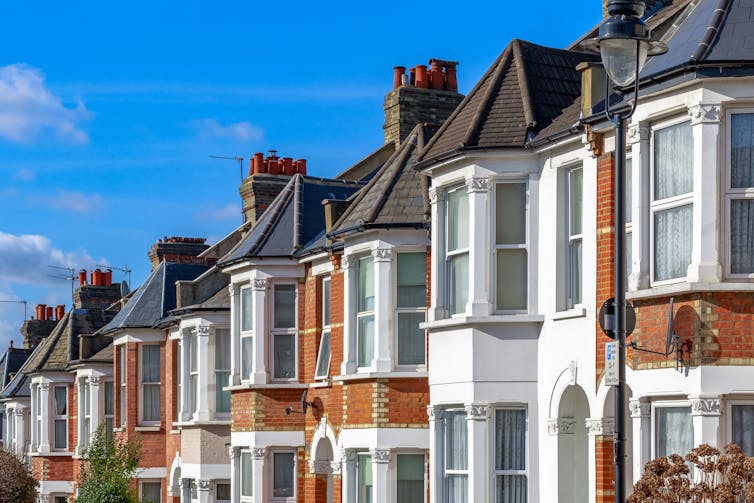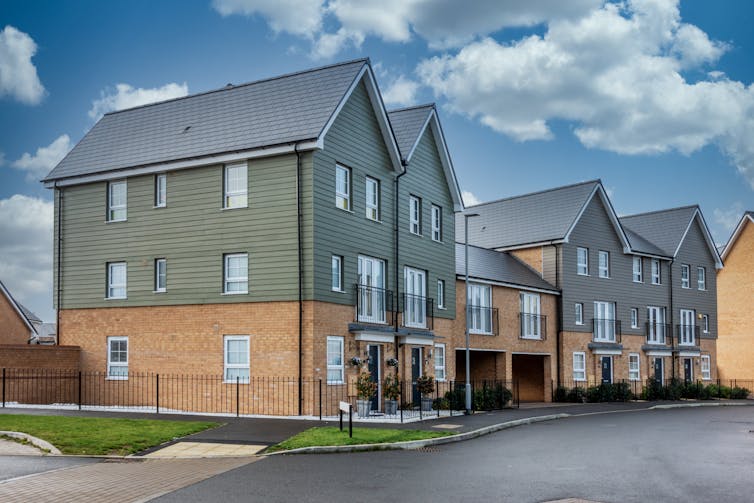Bogdan Sonjachnyj/Shutterstock
Lockdown shrank many of our physical worlds to our homes and their immediate neighbourhoods. However, the roles we needed to perform there expanded. Homes became offices, classrooms and gyms. Technology filled gaps and allowed homes to become remote social spaces.
Lockdown provided a unique opportunity to stress-test our homes and their immediate environments, and to gauge whether or not they have supported our everyday needs. Exploring this was the purpose of the Home Comforts survey, conducted by the Place Alliance, a not-for-profit initiative at UCL. The survey was completed by 2,500 households across the UK during the early summer of 2020.
A key finding from this research was that the least comfortable dwellings, least supportive neighbourhoods for everyday needs, and weakest sense of community correlated directly with the age of housing.
This suggests there are critical shortcomings in how new homes and neighbourhoods are designed. Our research provides insights into how we might need to design or adapt our homes in the future to build in a greater resilience and capacity to support happy and healthy lives.
Living under lockdown
The good news is that the majority of people in our survey felt comfortable in their homes (two-thirds), satisfied with their neighbourhood (three-quarters), and experienced a bolstered sense of community during lockdown (five-sixths).
Unfortunately, this still means that significant numbers of households had a much poorer experience. One-sixth of people felt uncomfortable in their homes – and if we extrapolated our results across the whole UK, this would add up to 11 million people. Similarly, this would mean that 10 million sensed no tangible change in community feeling, and 3 million are suffering the consequences of poorly designed neighbourhoods that do not meet their basic everyday requirements.

I Wei Huang/Shutterstock
The most recently built neighbourhoods – those constructed between 2010 and 2020 – recorded the lowest levels of satisfaction. The oldest neighbourhoods, those built before 1919, had the highest. Across all dwellings, the older the home, the more satisfied inhabitants were with their living conditions during lockdown.
Digging deeper, the survey revealed a range of critical factors – some relating to the design of homes, and some to neighbourhoods – that directly impacted on survey respondents’ sense of comfort and support. As each of these factors are more likely to be substandard in new developments, they also provide the explanation for why these residents came off worse.
Household space
Participants in our survey reported that access to private open space from the home was extremely important. Households with a private garden or terrace space were the most comfortable, followed by those with a private balcony or shared garden. Households with no access to any sort of private open space were considerably less comfortable.
Space standards were also critical, and dwellings were more comfortable the more rooms there were per occupant. Dwellings with five or more occupants were noticeably less comfortable during lockdown.
Good environmental conditions in the home, notably fresh air, daylight and good noise insulation, were widely seen as fundamental. Respondents often cited deficits in this regard, alongside a physical lack of space, as reasons why home working was challenging, particularly for social renters.
Unfortunately, as a housing design audit carried out by the Place Alliance suggested and this new survey confirms, in recent years we have let design standards drop. Too often new homes have poor internal-space standards, poor access to private open space, and are located in areas without basic amenities such as parks and shops.
Living within a five-minute walk of a park or significant green space was the strongest predictor of satisfaction with neighbourhoods during lockdown. Our respondents’ satisfaction reduced markedly the further away open space was, and significantly when it was over ten minutes away.
Another crucial factor for satisfaction with neighbourhoods was having local facilities (shops and services) within easy reach of the home. Again, satisfaction peaked when these amenities were within five minutes of respondents’ homes, and dropped away markedly over ten minutes.

Gordon Bell/Shutterstock
As we look likely to continue to spend more time in the home environment in the future, we need to build our homes and neighbourhoods as decent places where people wish to be. We need to learn from the stress test that lockdown has given our homes to build better living environments and to retrospectively adapt those we are living in today. This means decent space and environmental standards in the home and access to private open space – even if just a balcony.
Neighbourhoods should be walkable and cyclable, with convenient access to parks and local facilities, high quality streets and public spaces. Particular care is required to balance all these needs when building neighbourhoods that are dense and high.
![]()
Matthew Carmona does not work for, consult, own shares in or receive funding from any company or organisation that would benefit from this article, and has disclosed no relevant affiliations beyond their academic appointment.











